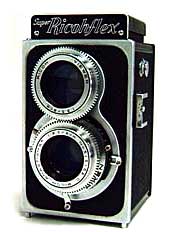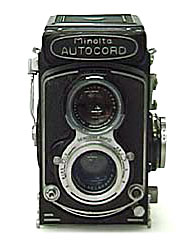| Attractive TLR
camera | What's
TLR camera? | Structure
of the TLR camera | History
of the TLR camera Variety of TLR cameras | Photograph with several TLR cameras | TLR camera selections |
| History of the TLR camera - Japanese TLR camera Around the late 1940s, TLR camera manufactures in Germany, and also Japan were severely damaged by the loss of the war. After that, the second TLR boom had spread out in Japan, and around the mid '50s, the gross number of the TLRs manufactured in Japan then arrived its peak at 400,000 a year. The reason why a tremendous number of TLR cameras had been sold was their cheaper price compared with the German-made's. Among them, RicohFlex was one of the leading camera of the boom, and gave other domestic camera manufacturers a big chance to emerge from the chaos after the war. |
 RicohFlex VII released in 1954. |
RicohFlex III
It is known that RicohFlex III released in 1950 was the one that lead, so-called, Japanese TLR camera boom. In those days, RolleiFlex was sold at about 90,000 yen in Japan with which you could eat chinese noodles (noodles again!) at 30 yen, which says that RolleiFlex was extremely expensive then. Then RocohFlex was launched. The price was 5,800 yen (and later 6,800 yen) which attracted the commonalty. As the way is was, it had been sold out at once, and invited the sutuation that the camera was always running short. It's said that its price was getting higher and higher on the black market because it was so hard to purchase in a legal way. As soon as the other camera manufactures looked at this, they started, and soon after that, over one hundred kind of TLR cameras were released on the market. |
 RicohFlex Super. The letters on the plate was changed into the script. |
RicohFlex Super
RocohFlex Super, first released in 1956, was manufactured to export exclusively into the U.S.A. Specifications and instructions are here. Ricoh had manufactured more TLR cameras other than these mentioned. Most of the TLR cameras manufactured then employed gear around the lens for fosucing instead of the bellows to cut the manufacturing cost and competitive with RicohFlex. Now, we know that the boom was based on the comcepts of "Cheap", "Neat" and "Durable", and some of the TLRs still work now for a wide range of people. I'm sure of this, that there's something more those, which full-automatic SLRs and disposable cameras don't have. |
 Minolta Autocord released in 1955. |
MinoltaFlex
Japanese camera manufacturers had depended on imported camera parts for a long time to manufacture cameras. Then, from about 1931, they finally could produce or get 100 percent domestic parts. Minolta, one of the high-qulity parts supplier then, released MinoltaFlex I in 1937 that was manufactured from the parts made all at Minolta, and equal to the German TLRs in abitily. Its appearance was just like that Rolleicord and Ikoflex was put together into one. Specifications and instructions of Minoltacord are here. |
|
| Mediajoy HP (Japanese) | Back to Top | Camera Shopper |
| Copyright by 1996-2002(C)MediaJoy All Rights Reserved. e-mail to mediajoy@mbox.kyoto-inet.or.jp |
||
